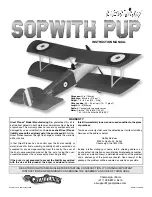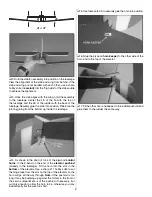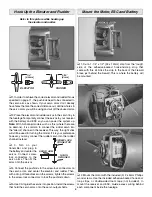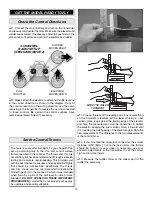
6
Hook Up the Elevator and Rudder
Refer to this picture while hooking up
the elevator and rudder.
5/16"
[8mm]
1/4"
[6.5mm]
RUDDER
ELEVATOR
❏
1. In order to achieve the correct elevator and rudder throws
specifi ed on page 11, the pushrods need to be connected to
the servo arms as shown. If your servo arms don’t already
have holes that are the correct distance out, drill new holes in
the servo arms you will be using and cut off the unused arms.
❏
2. Place the elevator and rudder servos in the servo tray in
the fuselage. Temporarily connect the servos to your receiver
with the battery and ESC so you can power the system up.
Note:
With 3-channel models such as this (where there are
no ailerons), it is common to connect the rudder servo into
the “aileron” channel in the receiver. This way, the right stick
will still be used for turning the model. If it is your preference
however, you may connect the rudder servo into the rudder
channel instead.
❏
3. Turn on your
transmitter and plug in
the battery and center the
servos. Connect screw-
lock connectors to the
servo arms. Then fi t the
arms onto the servos.
❏
4. Connect the pushrods to the screw-lock connectors on
the servo arms, and center the elevator and rudder. Then,
with a drop of threadlocker on the screws, tighten the screws
in the screw-lock connectors to lock the pushrods down.
❏
5. Use CA to glue the servos into position. Install the screws
that hold the servo arms onto the servo output shafts.
Mount the Motor, ESC and Battery
❏
1. Cut a 1-1/4" x 1/2" [32 x 12mm] strip from the “rough”
side of the adhesive-backed hook-and-loop strip that
came with this kit. Stick the strip to the back of the fi rewall
brace just behind the fi rewall. This is where the battery will
be mounted.
❏
2. Mount the motor with the included (3) 2 x 5mm Phillips
wood screws. Use the included adhesive-backed hook-and-
loop strips, or double-sided foam tape (not included), to
mount the receiver and ESC. Guide excess wiring behind
each component inside the fuselage.
SERVO ARM
SCREW-LOCK
CONNECTOR
NYLON
RETAINER






























